| Pages:
1
2 |
Lion850
National Hazard
   
Posts: 514
Registered: 7-10-2019
Location: Australia
Member Is Offline
Mood: Great
|
|
Copper cyanurate (and other cyanurates}
** There are many threads on copper cyanurate on Sciencemadness, for example:
http://www.sciencemadness.org/talk/viewthread.php?tid=155534...
http://www.sciencemadness.org/talk/viewthread.php?tid=29474#...
http://www.sciencemadness.org/talk/viewthread.php?tid=73900#...
But as far as I could see all involve the chlorinated compound while I wanted to try and make the 'basic' (for lack of a better word) cyanuric acid
salt. Thus I started a new thread.
I previously made the well known purple compound copper-sodium-dichloroisocyanurate but I was keen to try and make copper cyanurate. Wikipedia says
copper cyanurate forms in swimming pools when cyanuric acid reacts with high levels of copper, and shows a purple product.
I wanted to make copper cyanurate using only OTC materials. I had cyanuric acid and copper sulphate (from pool or hardware shops), sodium hydroxide
(from a local department store), and copper carbonate that I made a long time ago from copper sulphate and sodium hydroxide. See photo.
A few months ago I tried to react a cyanuric acid solution with both copper sulphate and copper nitrate and that did not seem to do anything. So this
time I decided to react copper carbonate with cyanuric acid:
CuCO3 + C3N3H3O3 = C3HCuN3O3 + H2O + CO2
- 11g cyanuric acid was added to 300ml water, stirred and heated. It seems quite insoluble until the solubility suddenly seems to increase at the
water boiling point and the solution then clears up.
- Slowly add 10g of copper carbonate, stirring all the time (to crudely check if my old carbonate still behaves as a carbonate i earlier added some to
a bit of concentrated HCl - it bubbled vigorously and all quickly dissolved into a green solution so seemed more or less good).
- A sea green suspension resulted with some foamy bubbles, which I presume was CO2. See photo.
- After 4 hours of stirring and keeping it warm the solution was grey, with a hint of purple which is hard to see on a photo. There was no more
bubbles, and no smell. I stopped the stirring and grey ppt settled out. See photo. I started the stirring again and left it going overnight, but it
looked the same the next morning.
- The solution was filtered. The filtrate was clear. The grey remainder was washed a few times with water in the filter.
- The clear filtrate was tested with sodium hydroxide, there was no ppt or cloudiness but just a very slight gold tinge; as I saw later this is often
observed when NaOH is added to cyanuric acid so my filtrate probably had a slight excess of cyanuric acid dissolved and no copper salts. Which was
good.
- The grey remainder was dried on a steam bath. The predominantly grey color became slightly lighter towards very pale purple. See photo.
- Final recovery of dry powder was 18g. The target from the above formula was 16g, so it is either not 100% dry (although it appears very dry and free
flowing) or it is a hydrate.
So, if this is copper cyanurate, why is it not a more pronounced purple color? I could not find another description of copper cyanurate anywhere. I
saw link to reports on studies of cyanuric acid reactions with metals, but they are not freely accessible. In swimming pools, when "copper cyanurate"
is said to form, there is of course always also sodium and chlorine present and I wondered if the presence of these are needed to get the purple
compound. This then lead to the next experiment which I will detail in the next post.
Comments from anyone with knowledge about copper cyanurate will be greatly appreciated.
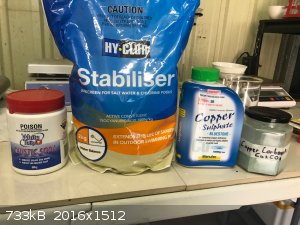 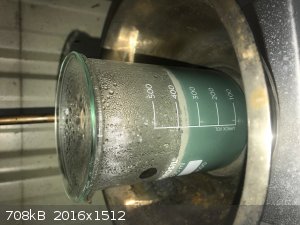 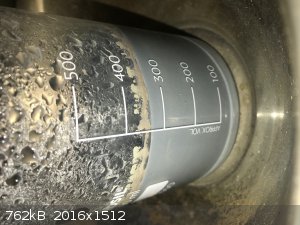 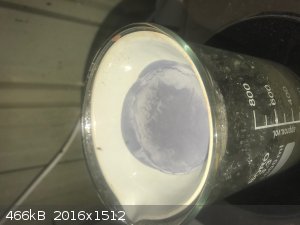
[Edit: title changed at request of OP.]
[Edited on 10-7-2020 by j_sum1]
|
|
|
Lion850
National Hazard
   
Posts: 514
Registered: 7-10-2019
Location: Australia
Member Is Offline
Mood: Great
|
|
Part 2.
The next step following from the above was to add sodium to the reaction to see if I get a purple compound. I did quite a few trial runs with various
results. Eventually the below ratios and method gave consistantly a similarly looking product.
The first step was to make sodium cyanurate in solution:
NaOH + C3N3H3O3 = C3H2N3NaO3 + H2O
- 16.5g of cuanuric acid was added to 450ml water, stir and heat.
- At boiling the solution just about cleared up, still slightly cloudy.
- Add 4g solid sodium hydroxide while stirring and keeping hot.
** These quantities was to allow for the cyanuric acid possible being a hydrate - if dehydrated, the acid is in excess. Important not to have the
sodium hydroxide in excess as this then yields unwanted copper hydroxide during the next part.
- As the NaOH is added the solution cleared up and again the very slight golden tinge was seen.
- After 20 minutes of stirring the solution turns white due to a suspension. I assume this is sodium cyanurate, whith low solubility in hot (bit not
near boiling) water?
- Stirring was continued for a total of one hour. pH was checked with my swimming pool test kit and found to be 8.
* This should have given some 15g of sodium cyanurate in solution (or rather suspension)
Next step was to add copper sulphate. But, I could not find a formula for copper-sodium-cyanurate (without the chloride) anywhere. The below equation
was one of a few that my app would allow, but the one which seems to best fit the amounts of reactants used and product yield:
2C3H2N3NaO3 + CuSO4 = Cu(C3N3NaO3)2 + H2SO4 + H2 ???
- 6g CuSO4.5H2O was added. The solution immediately turned purple. See photo. There seemed a bit of fizz for a few seconds but whether this was
hydrogen as per the formula I do not know. After 15 minutes stirring was stopped. A purple ppt settled, and the supernatant solution was very pale
blue. Another 2g of CuSO4.5H2O was added abd stirred for an hour, the supernatant solution was now more strongly blue indicating that copper sulphate
was now in excess. See photo.
- Vacuum filter. The filtrate was slightly blue, and the remainder purple.
- Wash a few times in the filter with room temperature water, until run-through is clear.
** The first time I tried to wash with boiling water, as I knew sodium cyanurate and cyanuric acid is much more soluble in boiling water. But the very
top layer of the purple compound turned green when in contact with the boiling water, plus the purple compound itself becomes soluble at boiling
point! See photo. I will investigate the formation of this green compound further.
- Dry the remainder on the steam bath for hours until the weight stabilised. See photo. The color slightly lightened as it dried.
- Final recovery was 15.1g of the fine dry light-purple powder. The color is a bit lighter than the better known copper-sodium-dichloroisocyanurate.
See photo of the 3 products together: the (suspected) copper cyanurate, the copper-sodium-cyanurate, and the copper-sodium-dichlorocyanurate.
So I got the purple color I was after, but a lot of assumptions and guessing what is actually going on. Please comment and correct as required! Links
to relevant literature will also be appreciated as I found very little.
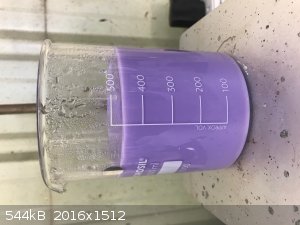 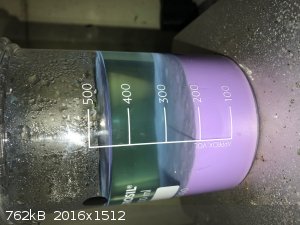 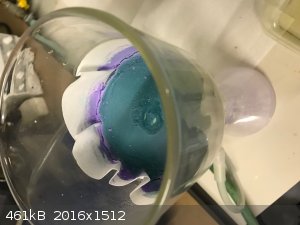 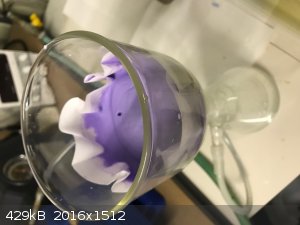 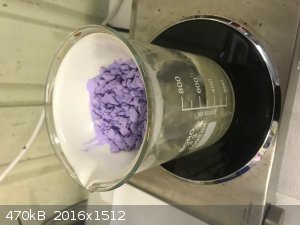 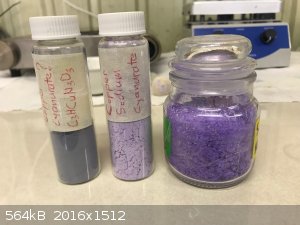
|
|
|
j_sum1
Administrator
       
Posts: 6218
Registered: 4-10-2014
Location: Unmoved
Member Is Online
Mood: Organised
|
|
My understanding is that the purple is a complex involving the NaDCCA salt. This indeed does form in swimming pools and is probably what is being
described.
I don't know anything about the copper cyanurate product you are after. But with the inclusion of HCl in your first procedure it is easy to imagine
you getting a mixture that includes a purple substance and appears grey as a consequence.
|
|
|
Bedlasky
International Hazard
    
Posts: 1219
Registered: 15-4-2019
Location: Period 5, group 6
Member Is Offline
Mood: Volatile
|
|
Nice looking product.
This isn't redox reaction, so there isn't any hydrogen formation.
[Edited on 20-6-2020 by Bedlasky]
|
|
|
Lion850
National Hazard
   
Posts: 514
Registered: 7-10-2019
Location: Australia
Member Is Offline
Mood: Great
|
|
Quote: Originally posted by j_sum1  | My understanding is that the purple is a complex involving the NaDCCA salt. This indeed does form in swimming pools and is probably what is being
described.
I don't know anything about the copper cyanurate product you are after. But with the inclusion of HCl in your first procedure it is easy to imagine
you getting a mixture that includes a purple substance and appears grey as a consequence. |
Hi J_sum1 I think I was not clear. In the first procedure there was only cyanuric acid and copper carbonate. HCl was only involved to crudely test the
old copper carbonate and give me some assurance it is indeed a carbonate prior to using it 
|
|
|
Lion850
National Hazard
   
Posts: 514
Registered: 7-10-2019
Location: Australia
Member Is Offline
Mood: Great
|
|
I found a review "Cyanuric Acid and Cyanurates" by G. B. Seifer online, I try to link it below:
Attachment: Cyanuric Acid and Cyanurates GB Seifer.pdf (335kB)
This file has been downloaded 516 times
Seems there are many different types of cyanurates formed and also various hydrates with different colors. See Table 1 on page 10 of the attached
file. A few more things to try!
|
|
|
Bezaleel
Hazard to Others
  
Posts: 444
Registered: 28-2-2009
Member Is Offline
Mood: transitional
|
|
This is a really awesome review article. It greatly helped me understand what went on when I was not able to produce the purple copper complex, when I
experimented with it in 2014.
Many who have experimented with TCA have not realised that somewhere in their process they lost some or all of the chlorine and were left with copper
cyanurate, instead of copper chlorocyanurate as they expected. Since I expected this, and wished to rule out one source of uncertainty, I worked with
cyanuric acid (or its sodium or potassium salt), which I obtained by dissolving TCA in HCl solution. The white precipitate formed is cyanuric acid.
(TCA + HCl (aq) --> CYA + Cl2)
|
|
|
woelen
Super Administrator
        
Posts: 7976
Registered: 20-8-2005
Location: Netherlands
Member Is Offline
Mood: interested
|
|
Very interesting result. So, it is clear that cyanuric acid can give a purple compound.
The reaction probably is very simple. Let's write the acid as H3X (with X being the remainder of the cyanuric acid molecule, containing C, N, O). Then
on addition of sufficient NaOH, you get Na3X in solution. It can also be that you get Na2HX or NaH2X in solution. As cyanuric acid is a very weak
acid, I expect one of the latter, a good candidate will be Na2HX.
With copper you then get CuHX: Cu(2+) + HX(2-) --> CuHX
No involvement of H2, no generation of H2SO4. Just a very simple precipitation reaction.
________________________________________________
It is interesting to investigate behavior at different pH-values. I doubt that you can get Cu3X2, most likely the ion X(3-) is too basic to allow
this. This is very much like that CuCO3 cannot be obtained, because CO3(2-) is too basic. You get a basic carbonate. Maybe at very high pH you get a
basic cyanurate.
So, I think there are multiple possible precipitates:
CuHX
Cu2(OH)X (the basic cyanurate)
Cu(H2X)2 ??
The different precipitates may have different colors. One of them is the bright purple compound, but there are others. A similar effect exists for
silver orthoperiodate. Orthoperiodic acid has 5 hydrogen atom, which can be split off, but in practice only the first two or three are split off,
except at very high pH. There are multiple silver orthoperiodates, with varying amounts of silver and hydrogen, e.g. Ag2H3IO6 and Ag3H2IO6. They have
different colors. Maybe such a phenomenon also exists for copper cyanurates. A lot to be investigated, and this set of experiments is a first step in
that direction.
It is best to do this research with true cyanuric acid and not with TCCA or DCCA. These contain chlorine and it is hard to get completely rid of that.
Maybe bezaleels method of adding TCCA to HCl and recrystallizing the cyanuric acid two times from boiling water leads to formation of the pure acid.
The pure acid is not easy to find OTC (at least not where I live), but I must admit, that I did not search very hard for that. At the regular hardware
stores and swimming pool shops it is all TCCA and Na-DCCA.
[Edited on 24-6-20 by woelen]
|
|
|
Lion850
National Hazard
   
Posts: 514
Registered: 7-10-2019
Location: Australia
Member Is Offline
Mood: Great
|
|
Woelen thanks for your comments. If you look at the document I reference in a previous post it is clear just how many different salts with colors also
dependent on hydration can be formed!
According to the msds the pool stabiliser that I use, the hy-clor product in the photo attached to my original post is 100% isocyanuric acid (which as
far as I can gather is aka as cyanuric acid). But I don’t know the purity and I don’t know whether it is the dihydrate or anhydrous. I emailed the
supplier to ask but no reply yet. I guess I can dissolve in water and recrystalize and then it will for sure be the dihydrate.
A lot more I want to do with this but no time to go to the shed the last few days!
|
|
|
woelen
Super Administrator
        
Posts: 7976
Registered: 20-8-2005
Location: Netherlands
Member Is Offline
Mood: interested
|
|
Isocyanuric acid is the same as cyanuric acid (a tautomer, but in solution they are equivalent).
Recrystallization from boiling water is possible. The acid dissolves quite well in hot water, but hardly in cold water.
|
|
|
Boffis
International Hazard
    
Posts: 1836
Registered: 1-5-2011
Member Is Offline
Mood: No Mood
|
|
Woelen is correct about cyanuric acid. I looked it up in one of my old chemistry books dedicated to cyanogen chemistry. Undr normal circumstances the
sodium salt is the mono salt ie NaH2C3N3O3 and the practically insoluble calcium salt Ca(H2C3N3O3)2. The di-sodium salt only crystallises from very
concentrated NaOH solutions (it doesn't say how concentrated!) and when recrystallised from water it disproportionates into the mono sodium salt and
NaOH solution. Even the first H+ is only weakly acidic, pKa value from wikipedia is given as 6.88 so weaker than acetic acid for the first hydrogen.
Recrystallising cyanuric acid requires about 25ml of boiling water per gram, more if you want to filter it hot.
|
|
|
Lion850
National Hazard
   
Posts: 514
Registered: 7-10-2019
Location: Australia
Member Is Offline
Mood: Great
|
|
Hi Boffis great info and what I see in the lab starts to make sense. Does your old book perhaps tell you if the hydrated cyanuric acid loses the water
when heated (before decomposition) and at what temperature?
Any mention of a grey copper and cyanuric acid salt? I got a grey looking but with very slight purple shade when I reacted copper carbonate (or
probably a mix of copper carbonates) with cyanuric acid. Still to be investigated further.
|
|
|
Boffis
International Hazard
    
Posts: 1836
Registered: 1-5-2011
Member Is Offline
Mood: No Mood
|
|
@Lion850; Cyanuric crystallises from water in anhydrous crystals, any water present means that it is simply not dry yet. William's book on the
chemistry of cyanogen compounds mentions several copper salts but unfortunately doesn't give any colour for the simple cyanurate Cu(H2C3N3O3)2 and
CuHC3N3O3. The later is prepared from copper salts and sodium cyanurate and the former by magnesium cyanurate on copper salt solutions. You should get
a copy of the book, I am pretty sure you can download it from the web, you want the 2nd edition 1948. Great book full of useful info.
Various amino copper salts are described as deep blue, violet and amethyst their preps are referenced. If you can't find a copy online I scan some of
my copy.
|
|
|
Lion850
National Hazard
   
Posts: 514
Registered: 7-10-2019
Location: Australia
Member Is Offline
Mood: Great
|
|
In my original posts up above I mentioned that at one point when I tried to wash the purple sodium copper complex with boiling water it formed a layer
of green. I investigated this further and after trying various things I was able to get the purple to green change again:
- 4.5g of purple sodium copper complex was added to approximately 250ml water in a beaker and stirred and heated, giving a purple colored
solution/suspension mix. See photo.
- As this was vigorously boiled the color changed to grey. See photo (interestingly, if boiling is continued it becomes purple again at a low water
volume).
- The contents was transferred to a large beaker and water added to a total of approximately 500ml and boiled and the color changed to green! See
photo.
- The solution was vacuum filtered while still hot. The filtrate was completely clear, and the remainder was green, see photo.
- The filtrate was later boiled down and then cooled, and gave white crystals. See photo.
So it seems the sodium copper complex breaks up when boiled in a large excess of water. I am not sure what the green copper remainder is; it is not
copper carbonate as there is no bubbling with HCl. It dissolves into a yellowish solution with concentrated HCl which becomes green when the HCl is
diluted.
Also to mention that on my stirring hotplate, which boils large volume solutions much less vigorously, I did not yet see this "break-up" happening. So
far, only on my cooking hotplate which is much more powerful.
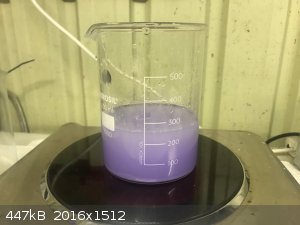 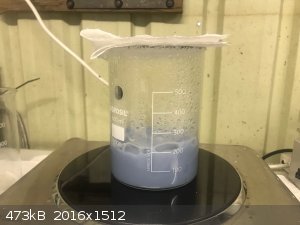 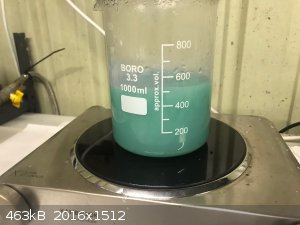 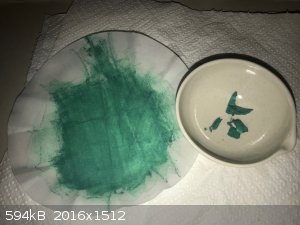 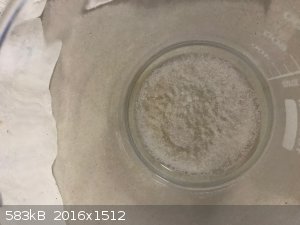
|
|
|
Boffis
International Hazard
    
Posts: 1836
Registered: 1-5-2011
Member Is Offline
Mood: No Mood
|
|
I suspect that on boiling with water the violet complex decomposes giving a ppt of some basic copper salt and a solution of sodium cyanurate or free
cyanuric acid, hence the colourless crystals at the end. It would be interesting to know what the anion is in the green material since copper
hydroxide would have turned black (CuO).
|
|
|
Diachrynic
Hazard to Others
  
Posts: 219
Registered: 23-9-2017
Location: western spiral arm of the galaxy
Member Is Offline
Mood: zenosyne
|
|
The purple compound, the "copper-sodium-cyanurate", in the second post is something I have prepared as well, the literature says it is a complex salt
of four monodeprotonated cyanurates, one central copper and two sodium ions as counter ions:
Na2[Cu(C3H2N3O3)4] This matches 1:1 the complex with NaDCCA by the way, which has
the formula Na2[Cu(C3N3O3Cl2)4]
The write-up (in German) can be found here, you can also prepare three ammonia derivatives of copper cyanurate, a di-, tri- and tetraammine compound:
https://illumina-chemie.de/viewtopic.php?p=76471
Werner says in his paper that the coordination happens over the deprotonated nitrogens to the copper center.
Here is the tetrakiscyanurate (left) and tetrakisdichloroisocyanurate (right) next to each other:
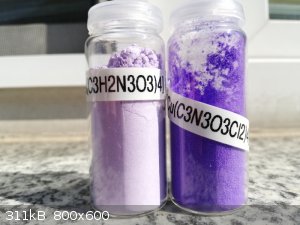
we apologize for the inconvenience
|
|
|
Lion850
National Hazard
   
Posts: 514
Registered: 7-10-2019
Location: Australia
Member Is Offline
Mood: Great
|
|
@Boffis - I managed to download the book but unfortunately only the first edition - still looking for a place to download the second edition that does
not want my credit card details.
Over the last week or so I reacted cyanuric acid with fine copper powder and finally got a lovely deep purple compound:
- 5.1g copper powder, 6g cyanuric acid, and 70ml water added to a small beaker (cyanuric acid in excess).
- Stirred with magnetic stirrer. Heated to near boiling once to dissolve the cyanuric acid and heat then switched off.
- Solution was initially copper colored due to the suspended copper powder
- After 24 hours still the same and I was just about to stop but then saw it was slightly less copper colored. Started to heat the beaker to around 50
degrees. Still some copper visible when stirring stopped.
- After 48 hours the copper color was much faded and it appeared to be heading to white-grey. Still copper present.
- After 72 hours it was starting to look purple. Mo more copper to be seen.
- Once it started to become purple the change was faster and after some 84 hours it was deep purple.
- After 96 hours the color was still the same deep purple and the stirring was stopped (4 days!)
- The solution was vacuum filtered. The filtrate was clear and the remainder a dark purple. The remainder was washed in the filter with excess water.
- A few gram of the remainder was dried on a steam bath to see if the color changed - it did not, and all was then dried on the steam bath.
- Final product was 10.6g of dark purple color.
The document I referenced and linked higher up "Cyanuric Acid and Cyanurates by GB Seifer" mentions only 2 salts for copper reacting on its own with
cyanuric acid: a trisubstituted salt Cu3C3N3O3.xH2O or a basic salt (CuOH)H2C3N3O3.2H2O; I do not know which one I ended up with but I am happy I
managed to get a purple copper cyanurate without any other metals included), which was the original target.
Below photos shows the color change from copper to dark purple and the final dried product.
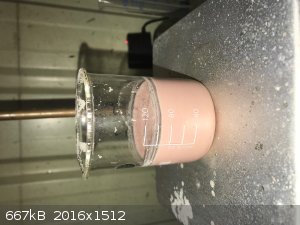 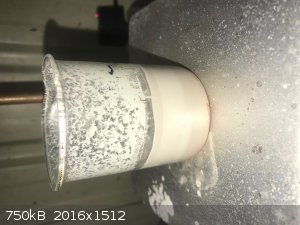 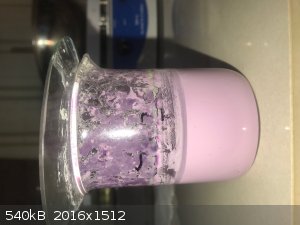 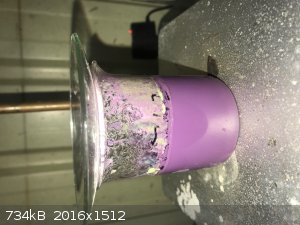 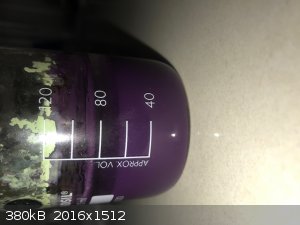 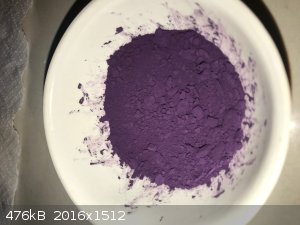
|
|
|
Lion850
National Hazard
   
Posts: 514
Registered: 7-10-2019
Location: Australia
Member Is Offline
Mood: Great
|
|
Manganese:
I had a go at reacting manganese powder with cyanuric acid. According to "Cyanuric Acid and Cyanurates by GB Seifer" linked in an post higher up,
manganese on its own forms either the disubstituted salt Mn2HC3N3O3 · xH2O or a basic salt (MnOH)H2C3N3O3 · 2H2O. I mixed 5.4g manganese powder and
8.6g cyanuric acid which puts the acid in slight excess assuming 1) the acid is the dihidrate and 2) the disubstituted salt will form. 90g water was
added and the lot was stirred with moderate heat.
There seem to be an immediate reaction with small bubbles, and after some 12 hours no more manganese powder could be seen and the solution was a pale
peach color. Stirring was continued for another 30 hours or so but there was no further color change. To note though was that the mixture became a bit
like a slurry, quite thick.
The solution was filtered; the remainder was very fine and a light tan color. It was dried on the steam bath until the weight was stable; this took
quite a while.
Final product was 13.5g of a white powder with a hint of pink. I've labelled the bottle "manganese cyanurate?" with no formula as I do not know
exactly what it is.
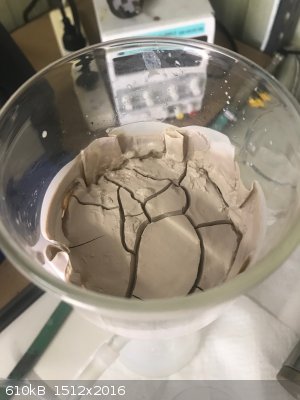 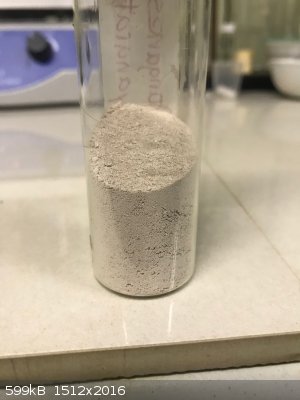
|
|
|
woelen
Super Administrator
        
Posts: 7976
Registered: 20-8-2005
Location: Netherlands
Member Is Offline
Mood: interested
|
|
I would not call that pink. I have the impression that the pure compound would be (nearly) white, but that there is a small amount of oxidized
manganese (oxidation stater +3 or +4, giving a darker color) in your product. Even a very low percentage of manganese(III) or manganese(IV) (e.gh.
0.1% or even less) can make your product look brown.
I myself have some MnCO3 of decent purity. Normally, this is a very pale pink, almost white powder. My powder has the same color as your powder. Still
it is quite pure.
|
|
|
Lion850
National Hazard
   
Posts: 514
Registered: 7-10-2019
Location: Australia
Member Is Offline
Mood: Great
|
|
Woelen - it certainly looks darker on the previous photo (of the dried product) than with the eye. I’ll take another photo in natural light. The
deep purple color of the copper compound got me keen to see which colors other metals may give 
Edit: Attached photo of the product of the cyanuric acid and manganese powder stirring plus, for interest, some manganese carbonate I made long go.
Photo taken outside on a cloudy day.
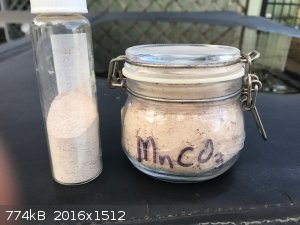
[Edited on 11-7-2020 by Lion850]
|
|
|
wg48temp9
National Hazard
   
Posts: 761
Registered: 30-12-2018
Location: not so United Kingdom
Member Is Offline
|
|
I tried a small test at making your copper cyanurate. I only had sodium dichlor isocyanuric acid. (DCA) I put some copper wire in a test tube
containing DCA and water. I then gentle heated the test tube in boiling water bath briefly.
After cooling the was a very slight purple sediment on top of the undissolved DCA and some purple blue deposits on the lower part of the wire. Part
of the deposit had apparently flaked off. Curiously the upper part of the wire remain bright copper coloured.
I suspect I need to add HCL.
Sorry about the almost useless pic. It was taken outside in the sun so that the colour was not distorted by my LED lighting. I could not see the
phone display very well in sun light. Modern mobile phone technology can not compete with our sun. The pic is of the heated test tube to dissolve the
DCA to reveal the wire and the precipitate.
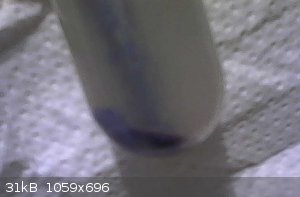
[Edited on 7/11/2020 by wg48temp9]
[Below is a slightly better pic taken with LED lighting showing the colour distortion and the copper wire. The test tube has cooled down so part of
the DCA is recrystallising.
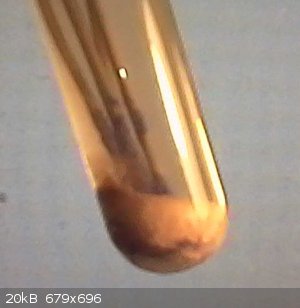
PS: the test tube is now at room temperature. All the copper wire is now covered with a light blue/purple deposit.
[Edited on 7/11/2020 by wg48temp9]
I am wg48 but not on my usual pc hence the temp handle.
Thank goodness for Fleming and the fungi.
Old codger' lives matters, wear a mask and help save them.
Be aware of demagoguery, keep your frontal lobes fully engaged.
I don't know who invented mRNA vaccines but they should get a fancy medal and I hope they made a shed load of money from it.
|
|
|
Lion850
National Hazard
   
Posts: 514
Registered: 7-10-2019
Location: Australia
Member Is Offline
Mood: Great
|
|
wg48temp9 - speaking under correction but I think the acid is Dichloroisocyanuric acid; if it joins with sodium it becomes the salt Sodium
dichloroisocyanurate. If you mix a solution of sodium dichloroisocyanurate and a solution of copper sulphate you get the well known purple sodium
copper cyanurate complex as precipitate.
I was keen to make a copper cyanurate compound without sodium and chlorine; which I eventually managed by reacting the copper powder and cyanuric acid
for 4 days under stirring. But I doubt if much would have happened if my copper was not a fine powder. It probably would have taken much longer with
bigger pieces of copper.
|
|
|
Lion850
National Hazard
   
Posts: 514
Registered: 7-10-2019
Location: Australia
Member Is Offline
Mood: Great
|
|
Cobalt:
Cobalt carbonate (see photo) was reacted with cyanuric acid to see what will happen. Reagent ratios were what I thought was appropriate to arrive at a
monosubstituted salt CoH2C3N3O3.xH2O, with the cyanuric acid in slight excess.
- 15g cyanuric acid was dissolved in 150g water, on stirring hot place. Solution was heated to near boiling to get the cyanuric acid to dissolve. pH
was approximately 4.
- Cobalt carbonate was slowly added until a total of 10.5g was added. This resulted in a pink suspension swirling around. See photo.
- Temperature was kept at around 50C, After 17 hours the solution was still pink. Temperature was then increased to approx 60-70C.
- After another 2 hours (total 19) the solution was grey. See photo.
- After another 4 hours (total 23) the solution started showing blue-green shades, Temperature was increased to near boiling.
- At the 47 hour mark the solution was blue-green (see photo) but becoming very thick and difficult to stir. Water was added to increase the total
volume from 300 to 400 to enable stirring.
- Color remained stable and at the 50 hour mark the heat was switched off but stirring maintained. As the solution cooled slowly the color changed
back to more grey.
- At the 65 hour mark stirring was stopped and the grey ppt allowed to settle. The pH of the clear supernatant solution was approx 7.
- The solution was vacuum filtered and the grey remainder washed with excess water in the funnel before being recovered. See photo.
- The remainder was divided in two equal lots. One was taken outside to dry under a steel dish in the sun (still in progress).
- The second part was dried on a steam bath. It started to show hints of color but for most part still grey when fully dry. Dry weight was 11.5g
- It was then put in a crucible in a sand bath at around 220C. After a short time it turned blue. It was kept on the sand bath another 30 minutes and
stirred every so often.
- After 30 min there was an occasional hint of an ammonia like smell and the crucible was cooled down. The color did not change during cooling.
- Final weight was 10g, so drying on the sand bath seemed to cause 1.5g weight reduction. The blue powder is very light and adheres to everything. See
photo of the final product in the crucible.
I wish I knew what the final product is, I suspect it is some cobalt cyanurate salt but which I don't know. Any ideas from the color?
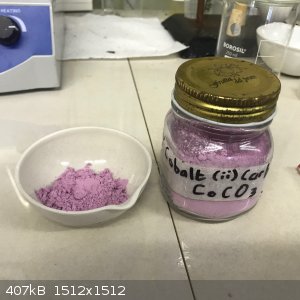 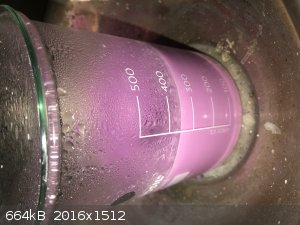 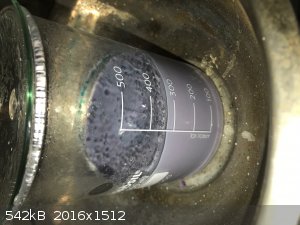 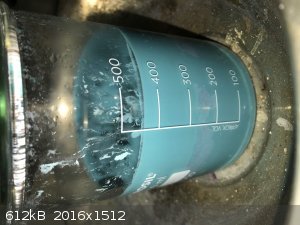 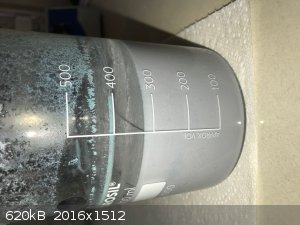 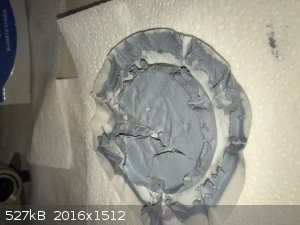 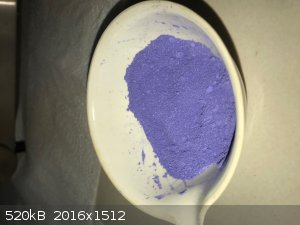
|
|
|
Lion850
National Hazard
   
Posts: 514
Registered: 7-10-2019
Location: Australia
Member Is Offline
Mood: Great
|
|
Cobalt continued:
The grey cobalt cyanurate salt was dried in the sun under a steel dish for 2 days. The final weight is 13g, but although it seems a free-flowing dry
powder after grinding I think it probably still has some water. It did not change color, to my eyes it is grey. Which leads me to ask: how common are
grey compounds? I have grey metal powders, but this is my most grey compound.....which turns purple on the sand bath, as per previous post.
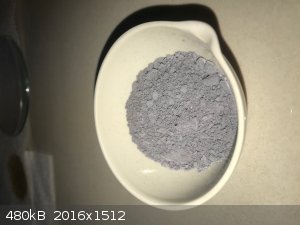
|
|
|
Bezaleel
Hazard to Others
  
Posts: 444
Registered: 28-2-2009
Member Is Offline
Mood: transitional
|
|
Quote: Originally posted by Lion850  | Cobalt continued:
The grey cobalt cyanurate salt was dried in the sun under a steel dish for 2 days. The final weight is 13g, but although it seems a free-flowing dry
powder after grinding I think it probably still has some water. It did not change color, to my eyes it is grey. Which leads me to ask: how common are
grey compounds? I have grey metal powders, but this is my most grey compound.....which turns purple on the sand bath, as per previous post.
|
I noticed thermochromism in coppercyanurate earlier, see this thread. It seems like you found another example with cyanurate. 
|
|
|
| Pages:
1
2 |